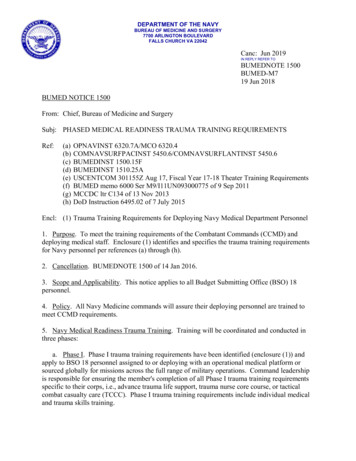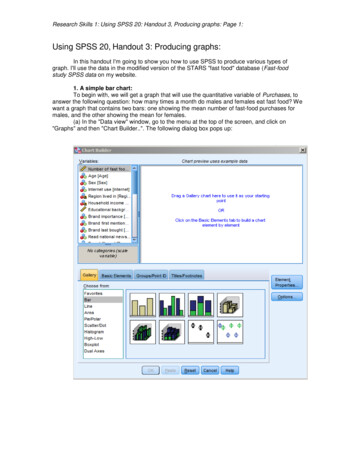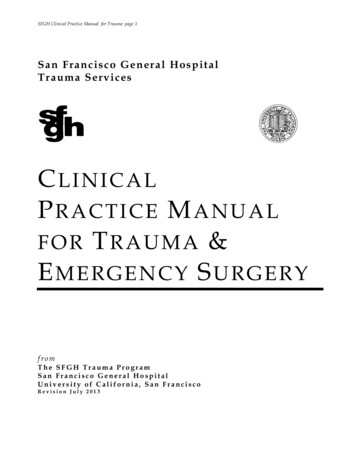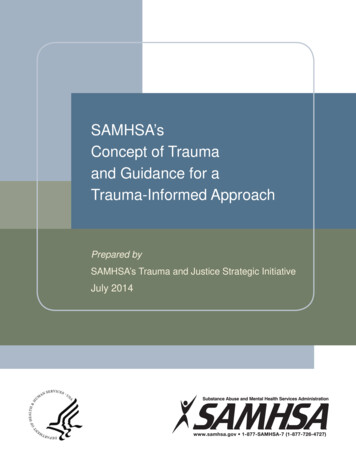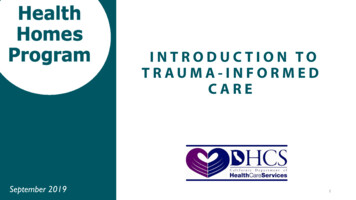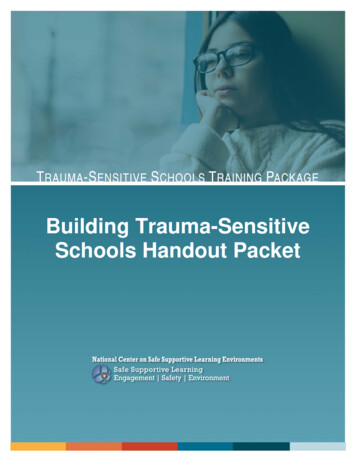
Transcription
T RAUMA -S ENSITIVE S CHOOLS T RAINING PACKAGEBuilding Trauma-SensitiveSchools Handout Packet
1. H ANDOUTSAudienceAll staff#1Handout TitleAPPLYING THE CORE PRINCIPLES WORKSHEETSchool leaders2STAFF DEVELOPMENT PLANNING GUIDEAll staff3SECONDARY TRAUMATIC STRESS AND SELF-CARE PACKETAll staff4MAPPING TRIGGERS AND OPPORTUNITIES ACTIVITYAll staff5NAVIGATING CRISES WORKSHEETStudent services6TRAUMA-SENSITIVE ASSESSMENT AND PLANNING CHECKLISTStudent services7All staff8SOCIAL AND EMOTIONAL COMPETENCIES CHECKLISTAll staff9STRATEGIES FOR COLLABORATIONSchool leaders10GUIDING QUESTIONS FOR POLICIES AND PROCEDURESGUIDELINES FOR ADOPTING A MULTITIERED APPROACH TOADDRESSING TRAUMABUILDING TRAUMA-SENSITIVE SCHOOLS: HANDOUTSDOCUMENT RELEASED FOR PILOT PURPOSES ONLYII
I NTRODUCTIONThis Handout Packet includes all of the downloadable resources found throughout the BuildingTrauma-Sensitive Schools online module. Each of these handouts is available for individualdownload as staff work through the module. Some handouts are relevant to all school staff andother handouts are designed for staff in particular roles, such as school administrators andtrauma-sensitive work groups supporting staff development and student services staffconducting student assessments or evaluations and providing services to students.Uses for HandoutsSchool staff may download and complete each handout individually during or after viewing theBuilding Trauma-Sensitive Schools Module to further your learning about trauma sensitivity andabout how to apply a trauma-sensitive approach in your role.School administrators and trauma-sensitive work groups can review the handouts together asyou begin to create your action plans for adopting a trauma-sensitive approach. Whereapplicable, handouts include suggestions for how work groups can use the material to supportaction plans for implementing a trauma-sensitive approach located in the Action Guide.School administrators and trauma-sensitive work groups can use the handouts as part ofongoing professional development activities related to trauma sensitivity. Even if staff downloadthe handouts on their own, it can be helpful to revisit the concepts at a later date. For example,school leaders may use certain handouts as part of a training day or staff meeting to exploreand reinforce particular concepts.BUILDING TRAUMA-SENSITIVE SCHOOLS: INTRODUCTIONDOCUMENT RELEASED FOR PILOT PURPOSES ONLY1
All staff handout1. A PPLYING THE CORE PRINCIPLES WORKSHEETTrauma-sensitive schools are grounded in a set of core principles that inform everyday schooloperations. For some schools and districts, these core principles align with existing culture andpractice, and for other schools and districts, the core principles represent a significant shift.Consider how you currently integrate the core principles into daily practice and what more canbe done to support a trauma-sensitive learning environment.1. Understand trauma and its impact.In a trauma-sensitive school, all staff share a common understanding of trauma and itsimpact on students, families, and staff and a joint mission to create learningenvironments that acknowledge and address trauma’s impact on school success.Here’s how my school currently integrates an awareness and understanding of trauma and itsimpact into daily practice:Here’s how I currently integrate an awareness and understanding of trauma and its impact intomy daily work:Here’s what I think we can do more of:2. Believe that healing happens in relationships.Trauma-sensitive schools believe that establishing safe, authentic, and positiverelationships can be corrective and restorative to survivors of trauma and can beresilience building for all. This principle encompasses relationships among and betweenschool staff, students, and families.HANDOUT 1: APPLYING THE CORE PRINCIPLES WORKSHEETDOCUMENT RELEASED FOR PILOT PURPOSES ONLY2
Here’s how my school demonstrates a commitment to fostering healthy relationships:Here’s how I demonstrate my commitment to fostering healthy relationships:Here’s what I think we can do more of:3. Ensure emotional and physical safety.Trauma-sensitive schools are committed to establishing a safe physical and emotionallearning environment where basic needs are met; safety measures are in place; andstaff responses are consistent, predictable, and respectful.Here’s how my school upholds a commitment to ensuring emotional and physical safety:Here’s how I uphold a commitment to ensuring emotional and physical safety:Here’s what I think we can do more of:HANDOUT 1: APPLYING THE CORE PRINCIPLES WORKSHEETDOCUMENT RELEASED FOR PILOT PURPOSES ONLY3
4. View students holistically.Schools invested in taking a trauma-sensitive approach understand the interrelatednature of emotional and physical health and academic success and the need to viewstudents holistically and build skills in all areas.Here’s how my school demonstrates a commitment to viewing students holistically:Here’s how I demonstrate my commitment to viewing students holistically:Here’s what I think we can do more of:5. Support choice, control, and empowerment for students, staff, and families.Trauma-sensitive schools operate in a way that supports choice, control, andempowerment for students, families, and staff and empowers all by building skills thatenhance sense of mastery.Here’s how my school demonstrates a commitment to supporting choice, control, andempowerment for students, staff, and families:Here’s how I demonstrate my commitment to supporting choice, control, and empowerment forstudents, staff, and families:HANDOUT 1: APPLYING THE CORE PRINCIPLES WORKSHEETDOCUMENT RELEASED FOR PILOT PURPOSES ONLY4
Here’s what I think we can do more of:6. Strive for cultural competence.Trauma-sensitive schools strive for cultural competence by acknowledging andrespecting diversity within the school; considering the relationship between culture,traumatic experiences, safety, healing, and resilience; and using approaches that alignwith the cultural and linguistic backgrounds of students, families, and the broadercommunity.Here’s how my school demonstrates a commitment to striving for cultural competence:Here’s how I demonstrate my commitment to striving for cultural competence:Here’s what I think we can do more of:7. Use a collaborative approach.Trauma-sensitive schools use a collaborative approach with students, families, andstaff. This approach includes sharing power and decision making across all levels of theschool and seeing students and families as partners.Here’s how my school demonstrates a commitment to using a collaborative approach withstudents, families, and staff:HANDOUT 1: APPLYING THE CORE PRINCIPLES WORKSHEETDOCUMENT RELEASED FOR PILOT PURPOSES ONLY5
Here’s how I demonstrate my commitment to using a collaborative approach when working withstudents, families, and staff:Here’s what I think we can do more of:HANDOUT 1: APPLYING THE CORE PRINCIPLES WORKSHEETDOCUMENT RELEASED FOR PILOT PURPOSES ONLY6
School leaders handout2. S TAFF DEVELOPMENT PLANNING GUIDEAdopting a trauma-sensitive approach schoolwide requires significant and ongoing investmentin professional development to ensure that the entire staff has the knowledge and skills tosupport students who are affected by trauma. This handout is designed to help school-basedadministrators and trauma-sensitive work groups create the plan needed for such aninvestment. A comprehensive professional development plan will cover multiple training topicsand will provide the following information for each topic: Topic title and brief descriptionAudienceTraining delivery method and rationale for useIntended learning outcomes that indicate participant mastery and/or application of newprofessional knowledge and skillsAt least one measurable benchmark or indicator for each outcomeEvaluation strategy to assess intended outcomes and indicators, including datacollection instruments, data-analysis techniques, and reporting methodFollow-up as needed to support learningResources to support professional development activitiesUse the form titled Staff Development Plan at the end of this handout to develop your plan. Foreach topic you address, make a copy of the blank form and then enter the information as youdevelop the activity.1. Topic title and descriptionProviding all members of the school staff with a basic education in trauma and its impact is animportant first step in the process of becoming a trauma-sensitive school. The UnderstandingTrauma and Its Impact e-resource and the Building Trauma-Sensitive Schools training modulesupport initial training efforts for all staff. Ongoing professional development builds on theseinitial training tools and provides additional information on trauma-related topics and helps staffdevelop skills associated with trauma sensitivity.In some cases, professional development activities associated with trauma sensitivity align withactivities supporting another approach, such as restorative practices or positive behavioralsupports. Describing the topics will help you anticipate such alignments.HANDOUT 2: STAFF DEVELOPMENT PLANNING GUIDEDOCUMENT RELEASED FOR PILOT PURPOSES ONLY7
Trauma-Related Topics for All Staff Child development and attachment and the effects of early adversityThe neurobiology of traumaParticular types of trauma (e.g., historical trauma, racial trauma, complex trauma)Experiences of particular groups of students (e.g., LGBTQ youth, youth of color, refugees)Relationship between culture and trauma (e.g., culture-specific experiences and responses)Secondary traumatic stress and vicarious traumaChild and adolescent mental healthResilience across developmentCore principles of trauma sensitivitySkill Building for All Staff General trauma-sensitive practicesTrauma-informed crisis intervention and de-escalation strategiesCulturally responsive practicesStrategies for engaging youth and familiesStrengths-based approaches to working with youthSelf-care strategiesRestorative practicesPositive behavioral supportsMental health first aidSpecialized Topics Classroom strategies for promoting safety (teachers)Social and emotional competencies and curricula (teachers)Trauma-sensitive assessment and evaluation practices (student services staff)Evidence-based, trauma-specific mental health interventions for addressing trauma(student services staff)2. AudienceMost topics will be useful for all staff, although some specialized topics specifically address theinformation needs of particular staff participants. Specifying the audience for each topic providesinformation for determining delivery method selection, choice of venue, and mechanism forannouncing the activity. Even more important, knowing the audience helps the organizer ortrainer focus and prepare each activity to meet any particular audience needs.3. Training delivery method and rationaleAdults learn most effectively when they are actively engaged in the learning process, causinggrowth to occur at the individual level and helping change occur in the broader schoolenvironment. Real change calls for ongoing and varied training, incorporating opportunities forstaff to practice applying concepts and to give feedback. Potential training delivery methodsinclude any of the following, each of which provides advantages and limitations that willcontribute to your rationale for using it:HANDOUT 2: STAFF DEVELOPMENT PLANNING GUIDEDOCUMENT RELEASED FOR PILOT PURPOSES ONLY8
Large-group training can be useful when providing initial staff and leader education abouttrauma and trauma sensitivity. Schoolwide trainings allow for all staff to receive the sameinformation at the same time, to ensure a common understanding across roles anddepartments. Training may be done in person or by having all staff review the same webbased materials and offering times for follow-up discussion. Although helpful when startingout, one-time, large-group trainings are only a place to begin and should not be usedexclusively. Staff retention of information is limited if concepts are not reinforcedcontinuously.Small-group training allows for in-depth conversation and offers opportunities to applyknowledge to practice. Small-group sessions may be conducted for all staff in a particularrole (e.g., teachers, student service staff, paraprofessionals) so that examples anddiscussions can be tailored. Small groups also may be multidisciplinary, to encourage crossagency communication and opportunities to learn what staff face in different roles, as well asflexibility in applying trauma-related concepts. As with large-group trainings, training contentmust be reinforced day to day to have long-term impact.Team or staff meetings already in place offer smaller settings in which to convey, clarify,and apply information on a regular basis. Small-group meetings are a forum for opencommunication, peer support, and additional training and education. These meetings mayinclude regular staff meetings, in which particular trauma-related topics can be addressed orreinforced each time, and department or shift meetings, in which learning can be tailored tothe specific needs of these staff.Real-world application provides opportunities to practice applying trauma-related conceptsin everyday situations. To further large- or small-group trainings, school leaders may identifyskills or strategies of focus for a particular time period, such as a skill of the month for allstaff to practice—for example, using strengths-based language, identifying potential traumatriggers, and incorporating self-regulation strategies in the classroom. All staff members arecharged with practicing a particular skill or considering a particular concept in their work.Staff or team meetings may be used for staff to report out on their experiences.4. Learning outcomes and benchmarksStaff development plans for supporting trauma sensitivity should include anticipated outcomesand measurable indicators of success. The components need to indicate who demonstrateseach outcome and benchmark. Each benchmark also needs to be measurable and time limited.Data for deriving this information may come from the evaluation strategies you choose and mayhelp determine your follow-up activities.HANDOUT 2: STAFF DEVELOPMENT PLANNING GUIDEDOCUMENT RELEASED FOR PILOT PURPOSES ONLY9
Sample Learning OutcomesBenchmarksTraining participants willdemonstrate an understanding ofthe neurobiological effects oftrauma. Training participants will be able toapply trauma-related concepts totheir classroom practices. During the session, teachers will identify specific strategiesthat they can use to reduce trauma-related triggers in theclassroom environment.Training participants will be able toidentify the warning signs ofsecondary traumatic stress orvicarious trauma. Within a week of the session, school staff will developindividualized self-care plans that incorporate helpfulstrategies for supporting health and wellness. Pre- and post-training surveys administered at the time ofthe session assess for knowledge change related to brainand body responses to stress and trauma.Upon receiving the information, participants will be able toidentify potential trauma-related responses by theirstudents.5. Evaluation strategyEvaluating professional development activities involves collecting data about the activity that tookplace and about the participation. Information gathered may include staff perceptions about theactivity and benchmark measurements that indicate whether the activity achieved the desiredoutcomes. Data gathered from professional development activities can be used as part of aschool’s larger efforts to evaluate the impact of trauma sensitivity on students, staff, and schools.Evaluation QuestionDid the professionaldevelopment take place asplanned?Data Collection Track individual staff participation via sign-in sheets.Track whether the activity or activities occurred at the intendedfrequency or duration as planned using tools such as activity logsfor tracking any follow-up.Note any factors that altered original plans related to theprofessional development.What were teachers’perceptions of theprofessional development? Survey training participants on topics such as their understandingof the purpose of the professional development, the usefulness ofthe activity, and the support they received to engage in and applylearning.Did the professionaldevelopment achieve theintended outcomes? Data collection is tailored to benchmarks indicating whether theprofessional development activity achieved your desiredoutcomes. For example, pre- and post-training surveys canassess knowledge change related to trauma and traumasensitivity.6. Follow-upDepending on the topic, mastery may benefit from staff feedback, trainer assessment, orrepetition or refresher activities. The needs of your staff will dictate the type of follow-up to offer.The following ideas are provided to stimulate your own ideas:HANDOUT 2: STAFF DEVELOPMENT PLANNING GUIDEDOCUMENT RELEASED FOR PILOT PURPOSES ONLY10
Provide opportunities for teachers to try out a new approach in the classroom and reportback on results during team meetings.Trainers can respectfully and unobtrusively observe or coach the staff on the job.Designate a particular time period for staff to practice the same skill. For example, in ageneral meeting announce a strategy of the month related to trauma sensitivity, such asdeveloping routines related to transition times.7. Resources to supportEffective staff development requires adequate resources, including time, staffing, facilities andequipment, and funding. School administrators and trauma-sensitive work groups identifyneeded resources for each trauma-related professional development activity. With limitedfunding and time for professional development, as well as competing demands related to stafftraining, consider how trauma-related topics align with other topics that may be of interest inyour school, such as restorative practices, school climate improvement, and positive behavioralsupports. Combining professional development efforts maximizes resources and helps staffunderstand the integration between various approaches.HANDOUT 2: STAFF DEVELOPMENT PLANNING GUIDEDOCUMENT RELEASED FOR PILOT PURPOSES ONLY11
Staff Development PlanCopy this form, and complete it for each topic.Topic title:Date:Description:Lead:Team:Audience:Training delivery method:Rationale for use:Learning outcomes:Benchmarks:Evaluation strategy:Follow-up:Resources for support:Action StepsPerson ResponsibleDate for CompletionHANDOUT 2: STAFF DEVELOPMENT PLANNING GUIDEDOCUMENT RELEASED FOR PILOT PURPOSES ONLY12
ReferencesMaryland State Department of Education. (2008). Maryland teacher professional developmentplanning guide. Baltimore, MD: Author. Retrievedfrom am, M. B. (2008). Maryland teacher professional development evaluation guide. Retrievedfrom NDOUT 2: STAFF DEVELOPMENT PLANNING GUIDEDOCUMENT RELEASED FOR PILOT PURPOSES ONLY13
All staff handout3. S ECONDARY TRAUMATIC STRESS ANDSELF - CARE PACKETEducators, counselors, and other support staff who work with students exposed to trauma are atrisk of being indirectly traumatized as a result of hearing about their students’ experiences andwitnessing the negative effects. In the first section of this packet, learn about secondary traumaticstress and related conditions; in the second section, use the tools and strategies provided to helpyou create individual and schoolwide plans to promote staff self-care and resilience.Secondary Traumatic Stress and Related ConditionsSecondary traumatic stress (STS) is the emotional distress that results when an individualhears about the traumatic experiences of another individual. Distress may result from hearingsomeone’s trauma stories, seeing high levels of distress in the aftermath of a traumatic event,needing to retell a student’s story, and/or seeing photos or images related to the trauma.Individuals with symptoms severe enough could be diagnosed with post-traumatic stressdisorder (PTSD). Common symptoms of STS include the following: Increased anxiety and concern about safetyIntrusive, negative thoughts and images related to their students’ traumatic storiesFatigue and physical complaintsFeeling numb or detached from studentsFeeling powerless or hopeless about students and the workDiminished concentration and difficulty with decision makingDesire to physically or emotionally withdraw from people or situations that trigger difficultthoughts and emotionsSeveral other terms capture elements of STS, often describing some terms slightly differentlyfrom STS.Burnout is characterized by emotional exhaustion, depersonalization, and a sense ofreduced personal accomplishment. Although burnout also is work related, burnout developsas a result of general occupational stress; the term is not used specifically to describe theeffects of indirect trauma exposure.Compassion fatigue is a less stigmatizing way to describe STS and can be usedinterchangeably with the term STS.HANDOUT 3: SECONDARY TRAUMATIC STRESS AND SELF-CARE PACKETDOCUMENT RELEASED FOR PILOT PURPOSES ONLY14
Vicarious trauma refers to internal changes in teachers and staff members who engageempathetically with a student affected by trauma. It is a theoretical term that focuses less ontrauma symptoms and more on the cumulative effects of exposure to details about anotherperson’s trauma.Compassion satisfaction describes the positive feelings derived from competentperformance as a trauma supporter. It is characterized by positive relationships withcolleagues and the conviction that one’s efforts contribute in a meaningful way to students,their families, and the community.Risk Factors for STS and Related ConditionsAny professional who works directly with children exposed to trauma and hears them recounttheir traumatic experiences is at risk of STS. Additional risk factors associated with STS andrelated conditions for professionals include: Prior trauma exposureFemale genderInexperience in the fieldDose of exposureType of workYoung ageHANDOUT 3: SECONDARY TRAUMATIC STRESS AND SELF-CARE PACKETDOCUMENT RELEASED FOR PILOT PURPOSES ONLY15
Warning Signs of Vicarious TraumaPersons who experience vicarious trauma undergo negative changes in their views of themselves, others, and the world. These negative changes eventually affect all aspects of daily life.Warning Signs of Vicarious TraumaHypervigilanceExcessive alertness for potential threats or dangers at and outside of work.Always being “on” and “on the lookout”Poor BoundariesLacking a balanced sense of your role so that you take on too much, step inand try to control events, have difficulty leaving work at work, or take thework too personallyAvoidanceCoping with stress by shutting down and disconnectingInability toEmpathize/NumbingUnable to remain emotionally connected to the workAddictionsAttaching to distractions to check out from work, personal life, or bothChronic Exhaustion/Physical AilmentsExperiencing physical, emotional, and spiritual fatigue or inexplicable achesand pains exceeding what you expect for an ordinary busy day or weekMinimizingTrivializing a current experience by comparing it with another situation thatwe regard as more severeAnger and CynicismUsing cynicism or anger to cope other intense feelings that we may notunderstand or know how to manageFeelings ofProfessionalInadequacyBecoming increasingly unsure of yourself professionally, second-guessingyourself, feeling insecure about tasks that you once felt confident to performHANDOUT 3: SECONDARY TRAUMATIC STRESS AND SELF-CARE PACKETDOCUMENT RELEASED FOR PILOT PURPOSES ONLY16
Tools for Staff Self-Care and ResilienceA number of individual and system-level strategies effectively promote staff self-care andresilience. This section includes the following tools for supporting individual and schoolwidestrategies for addressing and minimizing the effects of STS and related conditions: 3.1 Shared Strategies for Staff Self-Care and Resilience suggests individual andschoolwide strategies to support a culture of staff wellness.3.2 Staff Self-Care Plan begins with a personal inventory of warning signs, proceeds toan assessment of self-care practices, and concludes with making a commitment tospecific practices.3.3 School Self-Care Plan offers a process similar to developing an individual self-careplan but for the entire school.3.1 Shared Strategies for Staff Self-Care and ResilienceCreating a healthy work environment is a shared process that includes individual and schoolbased strategies. Explore these ideas for what you can do and what your school can do tofoster wellness for all.What You Can DoWhat Your School Can DoIncrease your knowledge and awareness of theeffects of trauma and STS.Educate staff about the effects of trauma, STS, andrelated conditions and provide regular opportunitiesfor staff to address potential issues related to STS.Assess your current level of burnout, STS, andvicarious trauma.Identify and monitor STS and related conditionsamong staff. Here are two tools that may be helpful: Compassion fatigue selftest http://www.ptsdsupport.net/compassion fatugue-selftest.html Professional quality of life scale, ProQOL5 http://proqol.org/ProQol Test.htmlStay connected to other people and groupsthat are supportive and nourishing.Encourage and develop formal strategies for peersupport and mentorship.Identify and incorporate specific self-carestrategies for promoting resilience andmaintaining a healthy work–life balance (e.g.,exercise, good nutrition, supportive networks).Create a culture that fosters staff resilience thatincludes: fair leave policies, adequate benefits, aphysically safe and secure working environment,sufficient supervision, support and resources to dothe work, and processes for shared decision making.HANDOUT 3: SECONDARY TRAUMATIC STRESS AND SELF-CARE PACKETDOCUMENT RELEASED FOR PILOT PURPOSES ONLY17
3.2 Staff Self-Care PlanUse this worksheet to create your own self-care plan. You do not need to share your answerswith anyone—this is simply for self-reflection. Check back regularly to see how things are goingand assess whether you need to make any adjustments to your plan.1. Recognize the warning signs.Becoming aware of the effects your work has on you is essential to helping you takecare of yourself. Think about the warning signs of STS and related conditions andconsider how they may be present in your daily life. Even if you are not regularlyexposed to student trauma, you may be struggling with issues of burnout or remnants ofyour own personal trauma experience. Feel free to add other signs that you are feelingoverworked, overextended, or overwhelmed.Warning SignYes or NoIncreased anxiety orconcern about safety Yes NoIntrusive, negativethoughts and imagesrelated to your student’straumatic experiences Yes NoDifficulty maintainingwork–life boundaries Yes NoAvoiding people, places,and activities that youused to find enjoyable Yes NoFeeling emotionallynumb, disconnected, orunable to empathize Yes NoIf Yes, Describe the Effect on YouHANDOUT 3: SECONDARY TRAUMATIC STRESS AND SELF-CARE PACKETDOCUMENT RELEASED FOR PILOT PURPOSES ONLY18
Warning SignYes or NoExperiencing feelings ofchronic exhaustion andrelated physicalailments Yes NoRegularly feeling angryand/or cynical aboutstudents, staff, and yourwork Yes NoFeeling inadequate inyour work andquestioning whetherwhat you do matters Yes NoIf Yes, Describe the Effect on YouOther:2. Assess your self-care practice.Many strategies are available to support self-care and reduce the signs and symptoms of STSand related conditions. Take some time to complete the self-care self-assessment below. Thistool provides ideas about how to practice self-care across many areas of your life. Rememberthat no one strategy works for everyone.How often do you do the following? (Rate, using the following scale):5–Frequently 4–Sometimes 3–Rarely 2–Never 1–It never even occurred to mePhysical self-careEat regularly (e.g., breakfast and lunch)Eat healthfullyExercise or go to the gymLift weightsPractice martial artsGet regular medical care for preventionDo physical activity that is fun for youTake time to be sexualGet enough sleepWear clothes you likeTake vacationsTake day trips or mini-vacationsTake time off when you are sickGet away from stressful technology,such as pagers, faxes, telephones, ande-mailGet massages or other body workOther:Get medical care when neededHANDOUT 3: SECONDARY TRAUMATIC STRESS AND SELF-CARE PACKETDOCUMENT RELEASED FOR PILOT PURPOSES ONLY19
Psychological self-careMake time for self-reflectionGo to see a psychotherapist orcounselor for yourselfExpress your outrage in a constructivewayPlay with childrenOther:Write in a journalRead literature unrelated to workSpiritual self-careDo something at which you are abeginnerMake time for prayer, meditation, andreflectionTake a step to decrease stress in yourlifeSpend time in natureNotice your inner experience—yourdreams, thoughts, imagery, andfeelingsParticipate in a spiritual gathering,community, or groupBe open to inspirationCherish your optimism and hopeLet others know different aspects ofyouBe aware of nontangible (nonmaterial)aspects of lifeEngage your intelligence in a newarea—go to an art museum,performance, sports event, exhibit, orother cultural eventBe open to mystery, to not knowingPractice receiving from othersSingBe curiousExpress gratitudeSay no sometimes to extraresponsibilitiesCelebrate milestones with rituals thatare meaningful to youSpend time outdoorsRemember and memorialize lovedones who have diedOther:Identify what is meaningful
This Handout Packet includes all of the downloadable resources found throughout the Building Trauma-Sensitive Schools online module. Each of these handouts is available for individual . School administrators and trauma-sensitive work groups can review the handouts together as . can be useful when providing initial staff and leader education .



